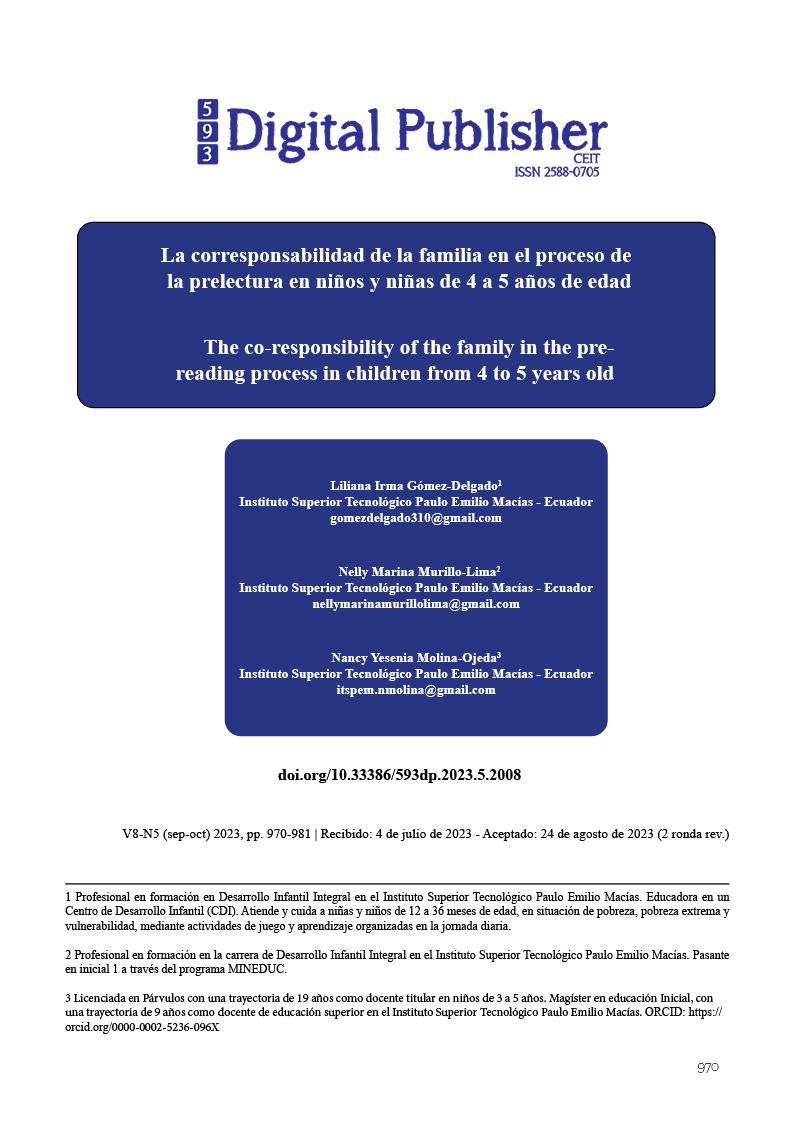The co-responsibility of the family in the pre-reading process in children from 4 to 5 years old
Main Article Content
Abstract
Reading and especially the pre-reading process not only involves educational institutions, but also and mainly the family context. It is a fact that boys and girls learn to read through their closest social relationships: the family, who play important roles in initiating their children's interest in reading. This project aims to develop reading ability in boys and girls from 4 to 5 years old through children's stories as a tool to stimulate the pre-reading process. In the same way, it seeks to make the family aware of their role in home education. Having trouble reading leads to difficulty learning the basic academic skills that occur during the developmental period and school years; basic academic skills such as: reading words, reading comprehension, spelling, and reasoning to solve mathematical problems. For this reason, families were given training where they were taught the strategies and techniques that they should use with their children to promote pre-reading. The results have shown that through children's stories, boys and girls have been able to improve their attention and comprehension of the texts that are read to them and have developed an efficient and complete pre-reading according to their age.
Downloads
Article Details

This work is licensed under a Creative Commons Attribution-NonCommercial-ShareAlike 4.0 International License.
1. Derechos de autor
Las obras que se publican en 593 Digital Publisher CEIT están sujetas a los siguientes términos:
1.1. 593 Digital Publisher CEIT, conserva los derechos patrimoniales (copyright) de las obras publicadas, favorece y permite la reutilización de las mismas bajo la licencia Licencia Creative Commons 4.0 de Reconocimiento-NoComercial-CompartirIgual 4.0, por lo cual se pueden copiar, usar, difundir, transmitir y exponer públicamente, siempre que:
1.1.a. Se cite la autoría y fuente original de su publicación (revista, editorial, URL).
1.1.b. No se usen para fines comerciales u onerosos.
1.1.c. Se mencione la existencia y especificaciones de esta licencia de uso.
References
Berger, K. (2007). Psicología del desarrollo: infancia y adolescencia, 7 edición. Madrid: Editorial Panorámica.
Campo, L. (2009). CARACTERÍSTICAS DEL DESARROLLO COGNITIVO Y DEL LENGUAJE EN NIÑOS DE EDAD PREESCOLAR. Rev. Psicogente, 12(22), 341-351.
Dorr, A., Gorosteguia, M., & Bascuñan, M. (2008). Psicología general y evolutiva. Santiago: Editorial Mediterráneo.
Gallardo, L., & Ferreas, A. (2000). Estrategias de aprendizaje. Primer Premio Nacional de Investigación Educativa 2000. Centro de Investigación y Documentación Educativa del Ministerio de Educación, Cultura y Deporte.
Gómez, V., & Jiménez, A. (2015). Corresponsabilidad familiar y el equilibrio trabajo-familia: medios para mejorar la equidad de género. Polis, Revista Latinoamericana, 14(40), 377-396. Obtenido de https://www.scielo.cl/pdf/polis/v14n40/art18.pdf
León, S. (2009). El rincón de la biblioteca, imprescindible en Educación Infantil. Revista digital para profesionales de la enseñanza.
Luque, A., & López, B. (2013). La prelectura como estrategia de mejora de la comprensión en el alumnado de 2º de ESO. Educación y Futuro Digital(7), 28-46.
Maganto, J., Etxeberria, J., & Porcel, A. (2010). La corresponsabilidad entre los miembros de la familia, como factor de conciliación. Educatio Siglo XXI, 8(1), 69-84.
Mendoza, N., & Perlaza, M. (2011). TÉCNICAS METODOLÓGICAS PARA INCENTIVAR LA PRE LECTURA. Universidad Estatal de Milagro.
Meza, J. (2000). Psicología Evolutiva de 0 a 12 años. Infancia intermedia. México: Editorial McGraw-Hill.
Peláez, R., García, D., Ávila, C., & Erazo, J. (2020). Análisis de la prelectura en Educación Inicial. Revista Arbitrada Interdisciplinaria Koinonía, 5(1), 692-710. Obtenido de https://dialnet.unirioja.es/servlet/articulo?codigo=7610729
Porras, J. (2011). La literatura infantil, un mundo por descubrir. Madrid, España: Liber Factory.
Rodón, E. (2018). Beneficios de leer cuentos a los niños. Revista Educere, 22(71), 193-196.
Romero, K. (2014). Pre-lectura en educación inicial desde el enfoque. Universidad de Cuenca. Obtenido de http://dspace.ucuenca.edu.ec/bitstream/123456789/20779/1/Tesis.pdf
Rosas, M., Jimenez, P., & Ulloa, P. (2005). Comprensión lectora y estrategias de enseñanza y aprendizaje: un caso de investigación acción. Rev. Lenguas Modernas, 30, 57-80.
Ruíz, G., & Ichau, N. (2014). La pre-lectura y su influencia en el desarrollo del lenguaje en niños niñas de 3 a 5 años en el Centro de Educación Inicial y primer año de Educación General Básica Francisco Javier Salazar de la parroquia de San José de Chaltura en el periodo comprendido. Universidad Técnica del Norte.
Tua, A. (2021). Corresponsabilidad de los padres en el proceso educativo de sus hijos durante confinamiento por covid-19. REVISTA EDUCARE, 25(2), 256-269. Obtenido de http://portal.amelica.org/ameli/journal/375/3752453016/3752453016.pdf
Ventura, N., & Durán, T. (2008). Cuentacuentos: Una colección de cuentos... para poder contar Tapa blanda . Madrid: Siglo XXI de España Editores, S.A.




